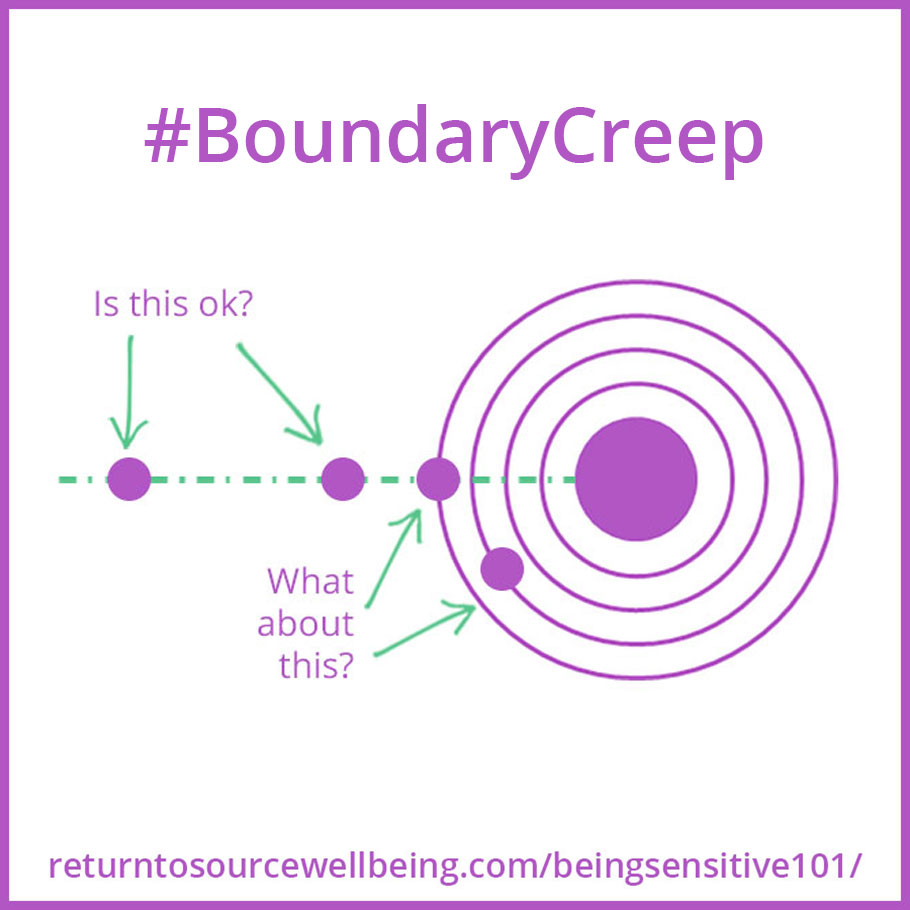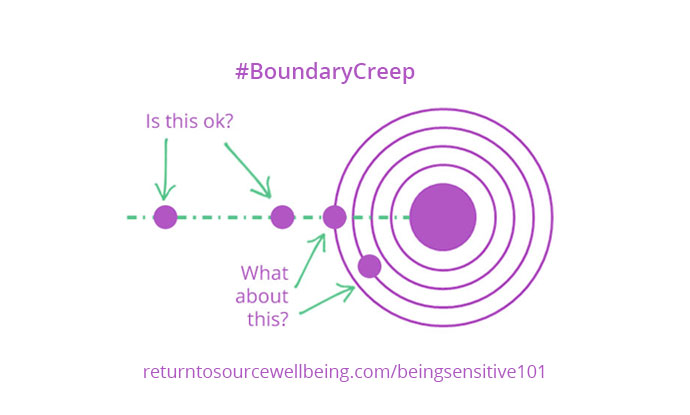This is one of the lessons from module 4 of my online course: Being Sensitive 101.
I’ve been talking about the topic of #BoundaryCreep for ages now!
You may have heard the term “scope creep”
Boundary creep is a similar idea. You don’t mean for your boundaries to be breached, but little issues can start to add up.
If you’re working on a project, scope creep might cause an increase in time or costs.
Boundary creep impacts your sense of safety and comfort.
Boundaries as concentric circles

Imagine your boundaries as a series of concentric circles. On the inside is your “inner sanctum”.
The outer-most circle reflects your outer boundaries – behaviours you might not enjoy, but that don’t bother you too much.
The circles in between represent issues you might feel less okay about, but they don’t set off major alarm bells.
An outer boundary might be something like… someone using your favourite tea mug without asking you first.
If that behaviour is repeated however, it could escalate to another circle closer to the inner sanctum. It all depends how you feel about your favourite mug!
What is a boundary violation?
This can be anything that you’re not okay with. Most of us have been taught to tolerate things we don’t like or don’t want to happen, but they’re all boundary violations.
They can range from mild to serious, and the only person who gets to decide that is you.
We have preferences about how we want to be treated and spoken to, and what sorts of behaviours we value, and dislike.
The only problem is, you often don’t know what you don’t like until you experience it.
Often, because we’ve been taught not to make a fuss about “little things”, we become conditioned to say nothing until our inner sanctum is being breached and someone is walking right into your bedroom while you’re still in your PJs.
Boundary creep starts with minor boundary violations
You might let minor boundary violations slide by and even if you feel uncomfortable, you might not let other people know. So the pressure and tension builds internally.
It’s kind of like… if your pet or your partner keep taking over more of your bed or the blankets.
They might not mean to, and you might keep allowing it because whatever, right? BUT if you don’t say or do anything about it, eventually you’ll end up in the corner with hardly any space and freezing cold!
This is boundary creep. Many people might not be aware of what an outer boundary even is for them!
What belongs on that outer circle for you?
It might be getting hugs from people you don’t know. Or having people touch you while they speak.
It could be anything, and you might perhaps describe these issues as slightly annoying.
And what’s on the next layer of the circle? And the next?
Often the first time people start to pay attention to boundary violations is when the inner sanctum has already been breached.
You’ve been holding on and not speaking up about outer boundary violations for a while, and so your frustration levels could be heightened!
So now all the alarm bells are going off. You might be feeling angry, defensive, and maybe even irrational.
It’s difficult to do anything other than react in ways you’d probably rather not when the inner sanctum has been breached.
But it doesn’t have to be that way
We don’t have to tolerate boundary violations, even the most minor ones. When we do, we tend to feel annoyed, right?
You can instead learn to speak up about what’s okay for you and what’s not much sooner. Starting with smaller issues.
Because if you can’t let people know what you like and don’t like, they can’t know you’re feeling uncomfortable, can they?
Imagine being able to calmly say:
That’s actually my favourite coffee mug. I know it’s awesome, but I’d really prefer that you use another mug. Never this one.
When you can say things like that with love and respect for the other person, then you can hopefully (although not always) avoid causing upset.
It’s worth getting clear on what you’re okay with and what you’re not okay with
And keep re-visiting this over time, because your boundaries can change.
The more practice you have saying what you do and don’t want, the easier it gets to repeat.
And if you’re keeping your outer boundaries safe and secure, you’ll probably find that you end up stopping boundary creep towards the inner sanctum!
So perhaps have a go at writing down what boundaries might be on different circle levels, to develop your awareness of what makes you uncomfortable.
Downloadable meme
Feel free to download and share the meme at the bottom of this post to anyone you think might like to know more about the concept of Boundary Creep!

Much love,

 |
Ambha Amanda Roberts is a Kinesiologist, Intuitive Healer, educator and facilitator based on the Sunshine Coast, Australia. She offers Kinesiology sessions both in-person and via Skype/Zoom all over the world. Ambha Amanda is the co-creator of Adventures of Staria, which includes a series of Staria cards, and an upcoming book for children (including inner children). |


